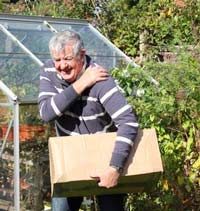Nonclinical studies have confirmed anti-inflammatory, analgesic, antipyretic, anti-platelet and COX-1 inhibition activities of ginger that mimics dual-acting NSAIDs
Anti-Inflammatory and Analgesic Activities
The anti-inflammatory, analgesic and antipyretic actions of an ethanolic extract of ginger in rats and mice have been confirmed by Ojewole, 2006. Either oral or intraperitoneal administration of a raw aqueous extract of ginger (500 mg/kg) given to rats daily for 4 weeks was effective in significantly reducing serum prostaglandin-E2 (Thomson et al., 2002).

Ginger constituents shogaols and gingerdiones mimic dual-acting non-steroidal anti-inflammatory drugs (NSAIDs) in vitroin intact human leukocytes (Flynn et al., 1968). In the early 1980s, ginger was shown to have anti-inflammatory actions, as evidenced by its inhibition of prostaglandins synthesis (Kiuchi et al., 1982). More recently, ginger and some of its constituents have been shown to be effective against cytokines at sites of inflammation (Grzanna et al., 2005). Ginger extract was found to be effective in inhibiting chemokine expression (Phan et al., 2005).
Gingerols and their derivatives have been reported to be more potent anti-platelet and cyclooxygenase-1 (COX-1) inhibitors than aspirin, when tested in vitro (Nurtjahja-Tjendraputra et al., 2003). It is established that neither ginger nor its constituents produce the gastrointestinal adverse effects that are usually produced by the conventional NSAIDs as a result of prostaglandin inhibition (Goldstein, 2004; Konturek et al., 2005). In fact, ginger has been shown to protect against ulceration in rats (Yamahara et al., 1988; Wu et al., 1990).
References:
- Flynn D, Rafferty M and Boctor A. (1968). Inhibition of human neutrophil 5-lipoxygenase activity by gingerdione, shogaol, capsaicin and related pungent compounds. Prostaglandins Leukot. Med. 24, 195–198.
- Goldstein J. (2004). Challenges in managing NSAID-associated gastrointestinal tract injury. Digestion 69 (Suppl. 1). 25–33.
- Grzanna R, Lindmark L and Frondoza C. (2005). Ginger–an herbal medicinal product with broad anti-inflammatory actions. J Med Food. 8(2): 125-32.
- Kiuchi F, Shibuya M and Sankawa U. (1982). Inhibitors of prostaglandin biosynthesis from ginger. Chem. Pharm. Bull. (Tokyo) 30, 754–757.
- Konturek S, Konturek P and Brzozowski T. (2005). Prostaglandins and ulcer healing. J. Physiol. Pharmacol. 56 (Suppl. 5). 5–31.
- Nurtjahja-Tjendraputra E, Ammit A, Roufogalis B, Tran V and Duke C. (2003). Effective anti-platelet and COX-1 enzyme inhibitors from pungent constituents of ginger. Thromb. Res. 111, 259–265.
- Phan P, Sohrabi A, Polotsky A, Hungerford D, Lindmark L and Frondoza C. (2005). Ginger extract components suppress induction of chemokine expression in human synoviocytes. J. Altern. Complement. Med. 11, 149–154.
- Thomson M, Al-Qattan K, Al-Sawan S, Alnaqeeb M, Khan I and Ali M. (2002). The use of ginger (Zingiber officinale Rosc.) as a potential anti-inflammatory and antithrombotic agent. Prostaglandins Leukot. Essent. Fatty Acid. 67, 475–478.
- Wu H, Ye D, Bai Y and Zhao Y. (1990). Effect of dry ginger and roasted ginger on experimental gastric ulcers in rats. Zhongguo Zhong Yao Za Zhi. 15, 278–280, 317–318.
- Yamahara J, Mochizuki M, Rong H, Matsuda H and Fujimura H. (1988). The anti-ulcer effect in rats of ginger constituents. J. Ethnopharmacol. 23, 299–304.